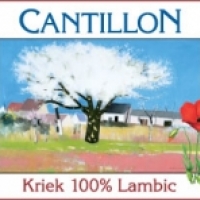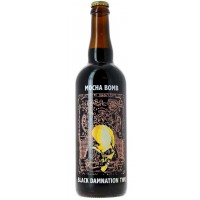Comprar Cantillon Kriek 100% Lambic Bio - Struise Black Damnation II Mocha Bomb - Kasteel Rouge
Kriek 100% Lambic Bio
The most famous among the fruit beers is without doubt the Kriek.
On a warm summer day, a lorry coming from the auction at Sint-Truiden delivers 4.000 kgs of fresh Kellery cherries to the brewery. The brewery staff will then put about 150 kgs of fruits in oakwood or chestnutwood barrels which can contain 650 litres of lambic and which have been cleaned some days before.
These barrels are filled with healthy lambics which are more or less one and a half year old. These are not so easy to find, because many beers are still ill at that age. These "oily" beers will have to mature for some months in the main barrel. When the Kriek barrels are filled with the fruits and with the lambic (about 500 litres), the hole in the barrel is closed with a sheet of paper in order to avoid contact with impurities.
Five days later, the fermentation starts. The sugars from the lambic and from the fruits bring about the activity of the yeasts which are concentrated in the wood and in the skin of the fruits. A marvelous pink or red foam decorates the old barrels in the cellar.
Normally, the fermentation stops around the 10th of August. The barrels are then closed and the acid lambic begins to extract the taste and the colour from the fruits. Flies and mosquitoes haunt the cellars and are likely to provoke bad infections. Due to the presence of the home spider, however, a natural predator which is more efficient than any insecticide, the Cantillon Brewery presents a natural equilibrium which enables us to produce our beers.
The fermentation of the Kriek in the bottle generally starts in the beginning of October. Two barrels of Kriek from the first extraction and two from the second are pumped into a huge barrel. (The second extraction is obtained by filling the barrel for a second time in order to extract as much from the fruits as possible). It is also possible to blend a certain quantity of young lambic with the Kriek in order to obtain a second fermentation in the bottle. The Kriek goes through a natural saturation, normally after three to five months in the bottle. We recommend to drink the Kriek within one year after the bottling.
The fermentation will change the primary taste of the product and the Kriek will be dominated by the character of the lambic. The red colour will change into more oily shades. This is, however, a personal point of view. Some customers conserve their Kriek for a long time and like it that way. Kriek is a traditional summer beer. It is a very thirst-quenching beer which tastes deliciously with a big slice of brown bread with white cheese, radishes, onions and chives.
Years ago, people who drank Kriek in a pub were also given two lumps of sugar and a "stoemper" on a small plate. With the "stoemper", the customer could crush the sugar on the bottom of his glass and sweeten it in a natural way in order to eliminate the sour taste.
Al igual que la Black Damnation I, mezcla Black Albert (De Struise) con la Hel & Verdoemenis (De Molen) pero con algunas particularidades: 50% es Black Albert madurada con granos de café colombiano, 25% Hel & Verdoemenis envejecida 6 meses en barricas de Jack Daniels en las instalaciones de Struise, y el 25% restante es la Struise Cuvée Delphine.
Kasteel Rouge es una mezcla de Kasteel Donker y licor de cereza. La mezcla de estos dos productos excelentes crea una cerveza suave excepcional, con referencias a la cerveza oscura madre.
- San Miguel Selecta - Estrella Galicia 1906 Galician Irish Red Ale - La Pelirroja
- Estrella Galicia 1906 Reserva Especial - La Milnueve - Estrella Galicia 1906 Galician Irish Red Ale - La Pelirroja
- Pilsener Ecuador - Pilsener
- Alfa Edel Pils - Agua Mala Sirena - Krušovice Imperial 5.0%
- Estrella Galicia 1906 Reserva Especial - La Milnueve - Estrella Galicia Pilsen - Voll-Damm
- Baias EKO - Baias IPA - Baias Kerala
- La Quince Saison Reggae - La Quince 15 Hours Session IPA Galaxy - La Quince God Save Extra Pale Ale
- Sesma Haka - Naparbier / La Quince The Attack of the Yellow Lizard - Brew & Roll Bele Beltza
- Santa Pau Pop Is Dead - La Pirata / Brew By Numbers Ozú Orange IPA - La Sitgetana Weiss Subur
- Illice Augusta Aurum - Pauwel Kwak - Delirium Christmas Noël
- Negra Modelo - Quilmes Red Lager - Modelo Ambar
- 19 Norte Spring IPA - Panda Beer Suco - 3Monos Monkey Python
- La Jamboise de Bister - St. Bernardus Tripel - Timmermans Oude Gueuze
- Estrella Damm - Damm Daura
- Bidassoa Basque Brewery / The Beer Garden The White Wave - Vihoppers´s IPA - Bidassoa Basque Brewery Amuitz
- Skol International - Estrella Galicia Especial - Estrella de Levante Clásica
- Kapittel Watou Prior - Grimbergen Héritage de l’Abbaye
- Maredsous Triple / Tripel - Maredsous Blonde / Blond - Duvel Tripel Hop Citra
- Pacífico Light - Corona Light - Tecate Light
- Estrella Galicia Especial - Estrella de Levante Clásica - Ambar Especial Sin Gluten
- Alhambra Reserva 1925 - Cruzcampo Gran Reserva - Estrella Damm
- San Miguel Especial - Amstel Clásica
- Omnipollo / The Veil Amun - Omnipollo Maz - Mazarin - Omnipollo Hypnopompa
- Montseny Negra - Evil Twin Aún Más a Jesús - Montseny Florale
- Brewdog Punk IPA - Lancashire Brown Ale - BrewDog 5AM Saint
- Negra Modelo - Indio - Victoria - Grupo Modelo
- Imperial Cream Stout - Guinness Draught - Quilmes Stout
- Alhambra Reserva 1925 - Mahou Clásica - Estrella Galicia Receta Original
- Andes Brewing Pale Ale - Andes Brewing Red Ale - Andes Aniversario IPA
- Amstel - Amstel Clásica - 18/70 La Rubia
- Huünen Lager Chilensis - Corona Extra - Budweiser
- Corona Light - Club Colombia Dorada
- Guinness Draught - Mercadona Doble Malta
- Voll-Damm - Deep Taste Heisenbier American Wheat Ale - Ambar Especial
- Gayant La Goudale - Blonde à l’Ancienne - L’Angelus - Manoir du Kinkiz Cidre Cornouaille
- Estrella de Levante 0,0 - Bavaria 0,0 - Erdinger Alkoholfrei
- Brooklyn Brown Ale - Flying Dog Raging Bitch - Samuel Adams Cherry Wheat
- Heineken - Ambar Especial
- Cruzcampo Radler - Desperados Original - Cerveza Sol
- Stella Artois - Club Colombia Dorada - Erdinger Weissbier
- Corona Extra - Gallo / Famosa
- Trappist Westvleteren 12 - Trappistes Rochefort 10
- Corona Light - Tecate Light - Coors Light
- Vudú Imperial Stout - Milana Pucela - Milana Milk in Black
- Trappist Westvleteren 12 - Dorita Dark Strong Ale - Charles Quint Rouge Rubis / Keizer Karel Robijn Rood
- Victoria Vicky Chamoy - Sol Clamato
- Cerex Pilsen Sin Gluten - Cerex Castaña - Cerex Andares
- Castelló Beer Factory Golden - Espiga Hoppy Dark Gose - Tacoa Passion Beer
- Maredsous Triple / Tripel - Maredsous Blonde / Blond - Bolleke De Koninck (APA)
- Mahou Cinco Estrellas - Heineken - San Miguel Blu
- El Águila Sin Filtrar - Alhambra Reserva 1925
- Robinsons Trooper - Black Sheep Ale - Samuel Smith Imperial Stout
- Colegiata Gold - Kunstmann Gran Torobayo - The Rolling Beer EPA
- Ambar Export - Mercadona Cerveza Reserva
- Estrella Galicia Especial - Carrefour Cerveza Holandesa Premium Quality - Amstel
- Estrella Galicia Pilsen - Molen Bier Cerveza Lager - Carrefour Cerveza Holandesa Premium Quality
- Montejo - Tecate - Carta Blanca
- Estrella Galicia 1906 Reserva Especial - La Milnueve - Cruzcampo Gran Reserva
- Flying Dog Snake Dog - Central Cevecera IPA - Medina Chinook Mosaic IPA
- Robinsons Old Tom With Chocolate - Samuel Smith India Ale - Wild Beer / 8 Wired Black & Blue



























